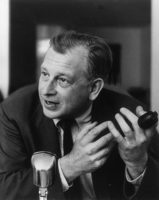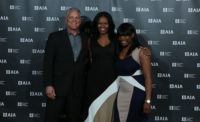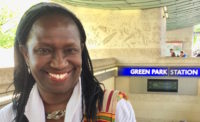Interview with Susan Saarinen
The landscape architect reflects on her father Eero and his influence on her work

Photo courtesy Susan Saarinen
“Welcome to my father’s church.” This is how Susan Saarinen commenced a lecture at Eero Saarinen’s 1964 North Christian Church in Columbus, Indiana, where design professionals and enthusiasts gathered in late September for Exhibit Columbus, an annual exploration of architecture, art, design, and community that alternates between symposium and exhibition years. Now in its third year, the event has brought renewed energy to the small city that has an abundance of architectural gems.
The daughter of the Finnish American architect Eero Saarinen and the sculptor Lilian Swann, Susan spent her early years at Cranbrook, in Bloomfield Hills, Michigan, where her grandfather, architect Eliel Saarinen, was the director. After resisting going into the family business, she came late to landscape architecture—a field that melds, she says, her love of natural materials and inherent design sensibility. She earned a Certificate of Landscape Design from Radcliffe College in 1986 and, in 1993, a Master of Landscape Architecture from the University of Colorado Boulder, near where she now lives and has her own firm. RECORD sat down with Susan in a rear pew at Eliel’s First Christian Church (1942).
The 2016 documentary Eero Saarinen: The Architect Who Saw the Future seemed like a way for your brother Eric, the coproducer, to reckon with your father’s workaholic tendencies, his divorce from your mother, and his early death at 51. Did you have a similar reckoning, professional or otherwise?
Eric had a very difficult relationship with our father. My relationship with him was not quite as difficult. That said, we both felt a great deal of pressure from the fame and the requirement of excellence that we grew up with. I wanted nothing to do with architecture because I didn’t like concrete or steel or glass. But I loved my grandfather’s architecture—it was brick and stone, and my grandmother’s textiles made everything warm and soft and friendly. I was 30 when I came to the realization [that landscape architecture was right for me]. So there was a lot of resistance, but once I understood that design of a different sort fit me perfectly, then I began to embrace the ideas that I grew up with in terms of design, drawing, balance, and proportion—things that started to come back into my consciousness.
We kind of lost our parents early: my mother was in a TB sanatorium for two years, and my father was working; then they divorced, and then my father’s death happened. There was a lot of losing along the way. It’s been both a tough journey and a strengthening one, and I’m so happy to see my brother come to terms with his early experience and to understand his father better now.
You’re currently working on your memoirs. Why did you decide to write them, and how far along are you?
I’m probably halfway through. I went to Finland in 1995 to learn more about my family, and I realized that, not only were they very talented designers and artists, but they were also really good people, and I decided that I wanted to share that with the world. When I left for Finland, I thought my family was unique. I got to Finland and I went, “Wait a minute, it’s Finnish!” When my family and I would walk into my grandfather’s house in Cranbrook, we would walk into Finland.
You mentioned after your talk at Exhibit Columbus that the redevelopment of the TWA terminal at John F. Kennedy Airport in New York into a hotel is heartbreaking for you. What would you rather see happen?
I don’t have an answer to that question, partly because I see the TWA building more as a sculpture, although it was a functional sculpture. If you chop off the back half of a sculpture, it’s a changed piece. But I’d rather have it there with the back half chopped off than not at all.
Tell me a bit about your style as a landscape architect and about a favorite project.
My approach is to meet the needs of my clients, stick to climate-appropriate plantings, and design the landscape, garden, courtyard, or campus to fit with the surroundings at every scale, as my father and grandfather taught me. My style tends to be comfortable, clean, and somewhat curvilinear. My favorite project was to create a welcoming, accessible entrance to Foothills Art Center in Golden, Colorado, incorporating an event terrace, sculptures, seating, and lighting. It was a community project with wonderful participation and cooperation.




